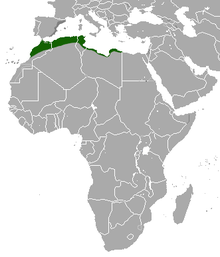North African hedgehog
| North African hedgehog[1] | |
|---|---|
 | |
| A North African hedgehog in the Balearic Islands | |
| Scientific classification | |
| Kingdom: | Animalia |
| Phylum: | Chordata |
| Class: | Mammalia |
| Order: | Eulipotyphla |
| Family: | Erinaceidae |
| Genus: | Atelerix |
| Species: | A. algirus |
| Binomial name | |
| Atelerix algirus (Lereboullet, 1842) | |
 | |
| North African hedgehog range | |
The North African hedgehog (Atelerix algirus), or Algerian hedgehog, is a species of mammal in the family Erinaceidae. It is found in Algeria, France, Libya, Malta, Morocco, Spain, and Tunisia. Little is known about this species of hedgehog, even though the most common breed of domesticated hedgehogs is a result of crossing a four-toed hedgehog with a North African hedgehog. Because this species of hedgehog is native to Africa, it has been suggested that it was introduced by humans to the other countries where it is now found, including France and Spain (including the Canary Islands). Of the four African species of hedgehogs, the North African hedgehog is the only one of these hedgehogs that can be found outside the continent of Africa.[3] Because the North African hedgehog has such a wide habitat range and has a seemingly stable population, both in the wild and in the domesticated capacity, it does not appear to be at risk at this time.
Description
The North African hedgehog closely resembles the European hedgehog but there are several distinct differences between the two species. The North African hedgehog tends to be smaller than its European counterpart, measuring anywhere from 200 to 250mm long.[2] However it is larger than the other African species of hedgehogs and has a longer snout and longer legs, making it a faster runner. Its face is light in colour, usually appearing to be white, and the legs and head are brown. The underbelly of this animal can vary in colour and is often either brown or white. Its ears are highly visible on the head of the animal and are large. The body is covered in soft spines, which are mostly white with darker banding.[4] It is most distinguishable from physically similar relatives by the lack of spines on the crown of the head, meaning a lack of the widow's peak.[5]
The species is commonly infested by the hedgehog flea, Archaeopsylla erinacei maura.[6]
Habitat
Very little is actually known about the preferred habitat of the North African hedgehog. It has been found in Mediterranean conifer and mixed forest climates as are present in southern mountainous regions of Spain and northern Africa.[7] In northern Africa, it can be found from Morocco to Libya, but is not able to survive in dry desert regions around this area. It can be found in other warmer regions as well, including parts of France, the Canary Islands, and the Balearics. Within these regions, it can often be spotted in garden and park areas.[4]
Reproduction
The gestation period ranges from 30 to 40 days and the litter size is between 3 and 10 hoglets. Two litters are often produced in a season (October to March). The hoglets generally weigh between 12 and 20 grams.[4] This species reaches sexual maturity at eight to ten weeks of age and does not mate for life, that is this hedgehog does not participate in pair bonding.[8]
References
- ↑ Hutterer, R. (2005). Wilson, D.E.; Reeder, D.M., eds. Mammal Species of the World: A Taxonomic and Geographic Reference (3rd ed.). Johns Hopkins University Press. pp. 212–213. ISBN 978-0-8018-8221-0. OCLC 62265494.
- 1 2 Amori G, Hutterer R, Kryštufek B, Yigit N, Mitsain G & Muñoz LJP (2008). "Atelerix algirus". IUCN Red List of Threatened Species. Version 2008. International Union for Conservation of Nature. Retrieved 2008-10-13.
- ↑ IUCN (1995). Compiled by Stone; R. David; IUCN; SSC Insectivore; Tree Shrew; Elephant Shrew Specialist Group, eds. Sub-family Erinaceinae Eurasian Insectivores and Tree Shrews - Status Survey and Conservation Action Plan Check
|url=value (help). Gland, Switzerland: IUCN. pp. vii + 164 pp. ISBN 2-8317-0062-0. - 1 2 3 Matthew M. Vriends (2000). Hedgehogs. Barron's Educational Series. pp. 64 pages. ISBN 0-7641-1325-9.
- ↑ Nick Lloyd (2007). "Alberian hedgehog". IberiaNature. Retrieved 2007-10-26.
- ↑ Jordan & Rothschild, 1912
- ↑ World Wildlife Fund (Content Partner); Mark McGinley (Topic; Cutler J. Cleveland, eds. (2007-03-12). "Mediterranean conifer and mixed forests". Encyclopedia of Earth. Washington, D.C.: Environmental Information Coalition, National Council for Science and the Environment. Retrieved 2007-10-13.
- ↑ Animal World (2007). "African hedgehog". African Pygmy Hedgehog. Retrieved 2007-10-28.
